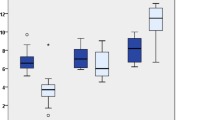Abstract
Objective
To assess the natural history and progression of subclinical hypothyroidism and to study factors which help predict evolution of subclinical hypothyroidism into overt hypothyroidism.
Methods
Longitudinal study in 40 children (2-16 yrs) presenting with subclinical hypothyroidism in a tertiary care unit in Chennai, India. Patients showing evidence of overt hypothyroidism or thyroid stimulating hormone ≥15 mIU/mL during follow-up were started on thyroxine. Others were followed up with 3-monthly thyroid function tests up to one year.
Results
At the end of our study period 3 (7.5%) were overtly hypothyroid, 16 (40%) remained as subclinical hypothyroid, and 21 (52.5%) became euthyroid. Evidence of autoimmunity at baseline was a significant (P<0.05) risk factor for progression to overt hypothyroidism.
Conclusions
Subclinical hypothyroidism in children, with thyroid stimulating hormone upto 15 mIU/L and irrespective of thyroid autoimmunity, needs only periodic clinical and biochemical follow up. Thyroid autoimmunity may point to an increased probability of progression to overt hypothyroidism.
Similar content being viewed by others
References
Surks MI, Ortiz GH, Sawin CT. Subclinical thyroid disease: Scientific review and guidelines for diagnosis and management. JAMA. 2004;291:228–38.
Canaris GJ, Manowitz NR, Mayor G, Ridgway EC. The Colorado thyroid disease prevalence study. Arch Intern Med. 2000;160:526–34.
Paoli-Valeri M, Maman-Alvardo D, Jiménez-Lopez V. Frequency of subclinical hypothyroidism among healthy children and those with neurological conditions in the state of Mérida, Venezuela. Invest Clin. 2003;44:209–18.
Gopalakrishnan S, Chugh PK, Chhillar M. Goitrous autoimmune thyroiditis in a pediatric population: A longitudinal study. Pediatrics. 2008;122:e670–4.
Shriraam M, Sridhar M. Subclinical hypothyroidism in children. Indian Pediatr. 2014;51:889–95.
Palaniappan S, Shanmughavelu L, Prasad HK, Subramaniam S, Krishnamoorthy N, Lakkappa L. Improving iodine nutritional status and increasing prevalence of autoimmune thyroiditis in children. Indian J Endocrinol Metab. 2017;21:85–89.
Leonardi D, Polizzotti N, Carta A, Gelsomino R, Sava L, Vigneri R, et al. Longitudinal study of thyroid function in children with mild hyperthyrotropinemia at neonatal screening for congenital hypothyroidism. J Clin Endocrinol Metab. 2008;93:2679–85.
Moore DC. Natural course of subclinical hypothyroidism in childhood and adolescence. Arch PediatrAdolesc Med. 1996;150:293–7.
Lazar L, Frumkin RB, Battat E, Lebenthal Y, Phillip M, Meyerovitch J. Natural history of thyroid function tests over 5 years in a large pediatric cohort. J Clin Endocrinol Metab. 2009;94:1678–82.
Valenzise M, Aversa T, Zirilli G, Salzano G, Corica D, Santucci S, et al. Analysis of the factors affecting the evolution over time of subclinical hypothyroidism in children. Italian J Pediatr. 2017;43:2.
Lee YJ, Jung SY, Jung HW, Kim SY, Lee YA, Lee SY, et al. Unfavorable course of subclinical hypothyroiditis in children with Hashimoto’s thyroiditis compare to those with isolated non-autoimmune hyperthryoptropinemia. J Korean Med Sci. 2017;32:124–9.
Nannipieri M, Cecchetti F, Anselmino M, Camastra S, Niccolini P, Lamacchia M, et al. Expression of thyrotropin and thyroid hormone receptors in adipose tissue of patients with morbid obesity and/or type 2 diabetes: Effects of weight loss. Int J Obes. 2009;33:1001–6.
Sanyal D, Raychaudhuri M. Hypothyroidism and obesity: An intriguing link. Indian J Endocrinol Metab. 2016;20:554–7.
Aijaz NJ, Flaherty EM, Preston T. Neurocognitive function in children with compensated hypothyroidism: lack of short term effects on or off thyroxine. BMC Endocr Disord. 2006;6:2.
Wasniewska M, Corrias A, Aversa T, Valenzise M, Mussa A, De Martino L, et al. Comparative evaluation of therapy with L-Thyroxine versus no treatment in children with idiopathic and mild subclinical hypothyroidism. Horm Res Paediatr. 2012;77:376–81.
Author information
Authors and Affiliations
Corresponding author
Rights and permissions
About this article
Cite this article
Sridhar, M., Mahadevan, S., Vishwanathan, L. et al. Subclinical Hypothyroidism: A Prospective Observational Study from Southern India. Indian Pediatr 55, 219–221 (2018). https://doi.org/10.1007/s13312-018-1321-5
Received:
Revised:
Accepted:
Published:
Issue Date:
DOI: https://doi.org/10.1007/s13312-018-1321-5




